Posted by Sunil Gangadharan on June 14th, 2007
Recently, I had a good showing at an arts and crafts festival near my house and I blogged a bit about the show here. What caught my interest peripherally during the show and more as I think about it now was the prevalence of crafts into shows like these and the dilution of the power inherent in the crafts by the artisans that create these crafts by purposely subverting their wares to dress them up like art. Let me explain. Close to my assigned booth, I met this charming lady (she is actually trained as a silversmith) who made jewelry. Her booth was crammed with styrofoam busts of women wearing custom designed jewelry and the whole setup looked really nice and beautiful from far. During short breaks from the steady stream of visitors, I would go by her booth and marvel at the designs that she created in silver and grimace at some designs that she created out of glass/silver. The silver creations were exquisite, the design fetching and the pieces very compelling to look at and buy (in fact I even asked my wife to look at a piece but she later chided me on the price). The jewelry made of painted glass beads on silver strands with the glass over painted with strange designs seemed lower in quality compared to her silver works. On asking her the price of the painted bead based jewelry, she explained that she was slowly branching out into ‘art’ and the prices for these were almost double the prices compared to equivalent silver pieces. I remember walking out of the booth with a strange feeling in my head.
Firstly, the painted glass pieces with a bit of silver strands were not good as the hand made silver pieces (from a purely aesthetic perspective) but they commanded extra prices because they were considered ‘art’.
Secondly, it looked like glass was being used for a purpose for which it is not inherently suitable – glass is great when blown or stained, but when it is hand painted and added along with other beads to make tacky jewelry, it loses the freshness inherent to glass and it makes for bad craft.
It almost seemed like the market forces that congregate around ‘art’ is pushing people to create work that is substandard and at the same time giving them less time to be more creative at what they are trained and good at… At the end of the day, I also understood that she sold much more silver pieces than the ‘art’ pieces.
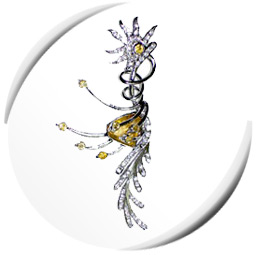 Sterling silver jewelry
Sterling silver jewelry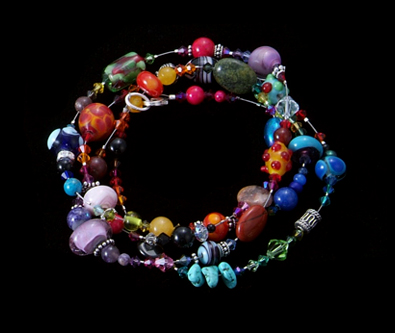 Necklace of glass beads
Necklace of glass beads
I was wondering why does she want to dress up her exquisite works under the word ‘art’ when her ‘craft’ can speak for itself (and very eloquently)? Why are craftspeople not proud to say that their work is ‘craft’ and keep trying to pay obeisance to art and try selling their works labeled as art? Is there a perception that when works are referred to as ‘art’, they are automatically elevated to another plane all by itself? Shouldn’t craft be on an equal plane? Is the word ‘art’ and by extension ‘artist’ over-hyped?
Posted by Steve Durbin on June 13th, 2007
I was struck by something David Palmer said (comment 7) on my recent post on waterfalls:
…there’s something about the waterfalls that really captures for me the change in energy we experience in winter. The actual slowing of molecules. It’s as though by seeing this microcosm we experience something much larger.
Very poetic and all, but beyond that? In any case, it inspired me to think about the water molecules that you could see if you zoomed in with a super-microscope. So I did just that — digitally. The images in the following sequence are waterfall #2 (chosen for its square format) and successive two-fold magnifications of the center of the preceding image (but the actual image display size is reduced by less than that, so they don’t get too small):
more… »
Posted by Steve Durbin on June 12th, 2007
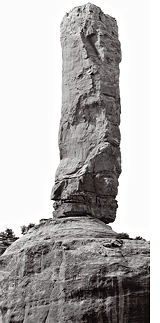 Sure the title is a pun I couldn’t resist, but it’s also the lead-in to a serious question about art and perception. It arose in the context of a photography trip to Utah last April, which began in Arches National Park. A few weeks ago, in Bones of the Earth, I made my first post about the project with that tentative title, which comes from the impression that the exposed rocks represent structures normally below the skin of the Earth.
Sure the title is a pun I couldn’t resist, but it’s also the lead-in to a serious question about art and perception. It arose in the context of a photography trip to Utah last April, which began in Arches National Park. A few weeks ago, in Bones of the Earth, I made my first post about the project with that tentative title, which comes from the impression that the exposed rocks represent structures normally below the skin of the Earth.
The rock formations in Arches and elsewhere are of many shapes. Among them are ones that can’t help but bring the word phallic to mind. The first picture I took that first morning (first image below) already fit into that category. That’s not why I made the photograph — at least not consciously — but it’s something that occurred to me at roughly the same moment I decided to set up the camera. And although the rock can certainly stand on its own as subject, it’s possible that the subliminal association helped draw my attention to it.
more… »
Posted by Karl Zipser on June 11th, 2007

Painting
From Life vs.
From Photos

I always enjoy painting skies. Part of the reason, I think, is that I never know the result ahead of time. The process of painting the skies is not entirely random, of course, but within the system of constraints I use, there is a large element of chance as to how they will develop. A slight unevenness in the over-painting blue becomes the seed of a cloud. The negative space of one cloud becomes the seed of another cloud. And so forth . . .
There is a big difference from photography here in the unfolding interaction with chance. A lucky photograph is made in milliseconds. Perhaps the result will inspire more photographs to capture the moment; but each photograph achieves its essential identity with the press of a button. Painting the skies is something more like an ongoing improvisation, technical context providing a stable base rhythm. The effects of chance are something I can explore over hours and days in the context of a single image.
Sunil’s post about luck in photography got me thinking about the role of chance in art. I wonder, is there an element of art that does not develop from some chance event? I’m on the verge of saying, art is about the harnessing of chance — except that is an oversimplification, and also I remember hearing it somewhere else before.
And yet, what is the alternative to the random? Religion informs us of the notion of Free Will. Science reminds us that there is only the random and the deterministic. Which makes better art?
Posted by June Underwood on June 8th, 2007
In a small art group that Jer and I belong to, we were given a challenge: for the next meeting, we were each to create some form of art based on “biscuits.” That meeting will be next week. I have to make some art. Using “biscuits” I came up with an anagram: “is Cubist.” I will make a Cubist-style painting, containing biscuits.
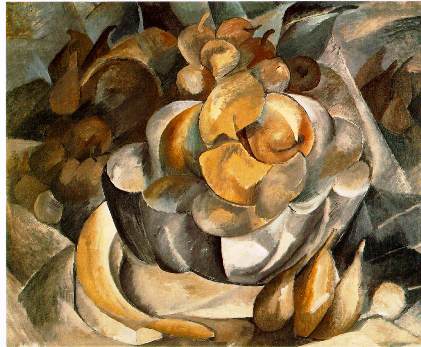
I thought the exercise would be simple. I would look at some Cubist works, get a couple books from the library and raid my bookshelves to see what others had to say, decide on motifs beyond the biscuits, and do a few sketches. Then, I would be ready to paint. more… »
Posted by Steve Durbin on June 5th, 2007
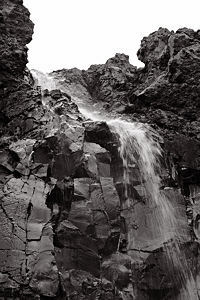 Yesterday I hiked up a mountain for a fabulous view of snow-covered peaks and dark green valleys for many, many miles in all directions. The only photographs I made were of a waterfall on the way up. The surprise is that I made any at all. Despite — or more likely because of — the clichéd nature of the subject, until a year ago I had essentially no waterfall pictures, even of locations I’d visited multiple times, with camera, where I more recently did make photos. Now I have half a dozen or so waterfalls, and I realize it has become a theme. So I want to start looking at them and thinking about them, learning from them.
Yesterday I hiked up a mountain for a fabulous view of snow-covered peaks and dark green valleys for many, many miles in all directions. The only photographs I made were of a waterfall on the way up. The surprise is that I made any at all. Despite — or more likely because of — the clichéd nature of the subject, until a year ago I had essentially no waterfall pictures, even of locations I’d visited multiple times, with camera, where I more recently did make photos. Now I have half a dozen or so waterfalls, and I realize it has become a theme. So I want to start looking at them and thinking about them, learning from them.
more… »
Posted by Doug Plummer on June 5th, 2007

Two recent blog entries, one by Paul Butzi (I’ve been riffing off him a lot lately) on photographing “Close To Home,” and Birgit’s “Dune Quest” have got me thinking about the notational aspects of artmaking. Namely, the daily investigation of ideas and how that relates to projects of “greater” importance.
more… »
 Sterling silver jewelry
Sterling silver jewelry Necklace of glass beads
Necklace of glass beads Sure the title is a pun I couldn’t resist, but it’s also the lead-in to a serious question about art and perception. It arose in the context of a photography trip to Utah last April, which began in Arches National Park. A few weeks ago, in
Sure the title is a pun I couldn’t resist, but it’s also the lead-in to a serious question about art and perception. It arose in the context of a photography trip to Utah last April, which began in Arches National Park. A few weeks ago, in 

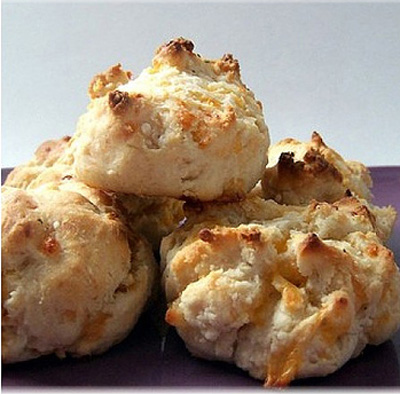

 Yesterday I hiked up a mountain for a fabulous view of snow-covered peaks and dark green valleys for many, many miles in all directions. The only photographs I made were of a waterfall on the way up. The surprise is that I made any at all. Despite — or more likely because of — the clichéd nature of the subject, until a year ago I had essentially no waterfall pictures, even of locations I’d visited multiple times, with camera, where I more recently did make photos. Now I have half a dozen or so waterfalls, and I realize it has become a theme. So I want to start looking at them and thinking about them, learning from them.
Yesterday I hiked up a mountain for a fabulous view of snow-covered peaks and dark green valleys for many, many miles in all directions. The only photographs I made were of a waterfall on the way up. The surprise is that I made any at all. Despite — or more likely because of — the clichéd nature of the subject, until a year ago I had essentially no waterfall pictures, even of locations I’d visited multiple times, with camera, where I more recently did make photos. Now I have half a dozen or so waterfalls, and I realize it has become a theme. So I want to start looking at them and thinking about them, learning from them.